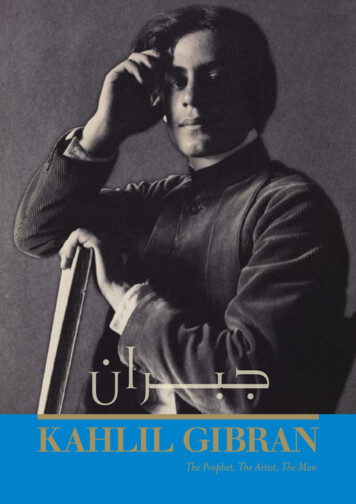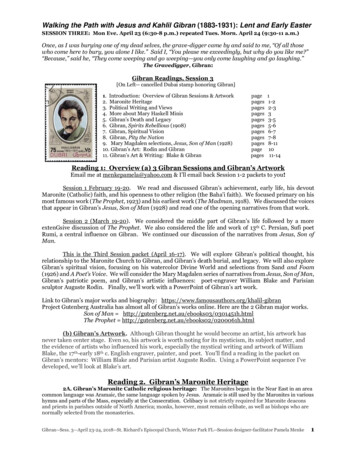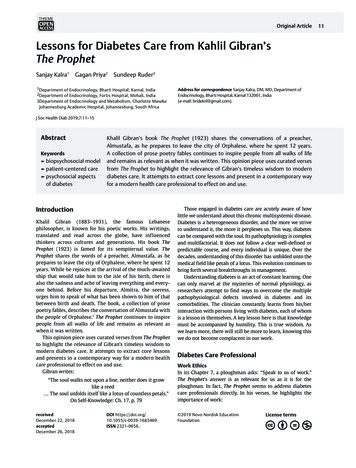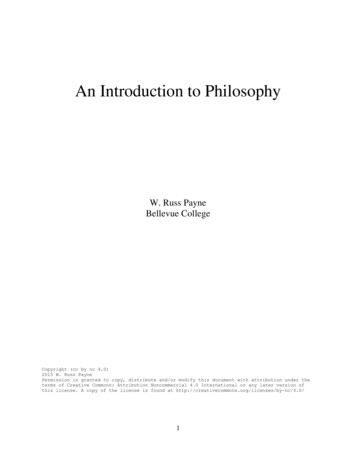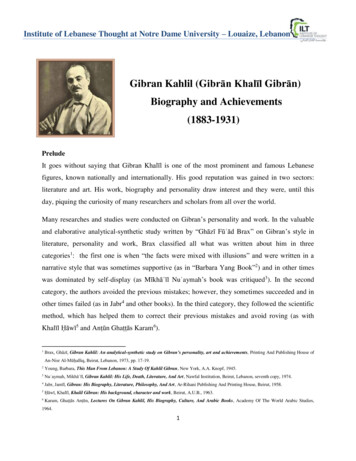
Transcription
Institute of Lebanese Thought at Notre Dame University – Louaize, LebanonGibran Kahlil (Gibrān Khalīl Gibrān)Biography and Achievements(1883-1931)PreludeIt goes without saying that Gibran Khalīl is one of the most prominent and famous Lebanesefigures, known nationally and internationally. His good reputation was gained in two sectors:literature and art. His work, biography and personality draw interest and they were, until thisday, piquing the curiosity of many researchers and scholars from all over the world.Many researches and studies were conducted on Gibran’s personality and work. In the valuableand elaborative analytical-synthetic study written by “Ghāzī Fūʾād Brax” on Gibran’s style inliterature, personality and work, Brax classified all what was written about him in threecategories1: the first one is when “the facts were mixed with illusions” and were written in anarrative style that was sometimes supportive (as in “Barbara Yang Book”2) and in other timeswas dominated by self-display (as Mīkhāʾīl Nuʿaymah’s book was critiqued3). In the secondcategory, the authors avoided the previous mistakes; however, they sometimes succeeded and inother times failed (as in Jabr4 and other books). In the third category, they followed the scientificmethod, which has helped them to correct their previous mistakes and avoid roving (as withKhalīl Ḥāwī5 and Anṭūn Ghaṭṭās Karam6).1Brax, Ghāzī, Gibran Kahlil: An analytical-synthetic study on Gibran’s personality, art and achievements, Printing And Publishing House ofAn-Nisr Al-Mūḥalliq, Beirut, Lebanon, 1973, pp. 17-19.2Young, Barbara, This Man From Lebanon: A Study Of Kahlil Gibran, New York, A.A. Knopf, 1945.3Nuʿaymah, Mikhāʾīl, Gibran Kahlil: His Life, Death, Literature, And Art, Nawfal Institution, Beirut, Lebanon, seventh copy, 1974.4Jabr, Jamīl, Gibran: His Biography, Literature, Philosophy, And Art, Ar-Rihani Publishing And Printing House, Beirut, 1958.5Ḥāwī, Khalīl, Khalil Gibran: His background, character and work, Beirut, A.U.B., 1963.6Karam, Ghaṭṭās Anṭūn, Lectures On Gibran Kahlil, His Biography, Culture, And Arabic Books, Academy Of The World Arabic Studies,1964.1
Institute of Lebanese Thought at Notre Dame University – Louaize, LebanonBrax, in his classification, seemed willing to put his study on Gibran in a forth category, whichadopts the analytical-synthetic approach, and is based on his achievements in literature,specifically in the psychology of art. Hence, he tried to bridge the gap, fix the disagreements, andavoid the contradiction in the assessments and prospects defecting the previous researches onGibran’s personality and work in art and writing.In this context, we can cite two more approaches adopted in the studies made later on Gibran,that are still under development. The first one was carried out by Kamāl Yūsuf Al-Ḥāj in hisencyclopedia called “the ( ) summary of the Lebanese philosophy”1 launched at the beginningof 1974. Ḥāj wanted in his study on Gibran to usher in a new era, adopting a philosophicalapproach based on the necessity to develop a philosophical system or structure comprising all theaspects of Gibran’s writings. However, Ḥāj study was the only one made and didn’t draw theattention of other researchers in their studies on other famous figures (such as Rihani, Nuʿaymah,Al-Chmayyīl, among others). Knowing that more than four decades elapsed since it wasconducted, and Ḥāj adopted it, to study other famous figures. The second one consists of theontological philosophical criticism in the critical studies of literature, which was made andadopted by the ontological French Philosopher Jean Paul Sartre in his analytical study on the lifeof the French poet Beaudelaire. It was also adopted by Nabīl Ayyūb inn his brief study onGibran, in his book called “Naṣ al-Qāriʾ al-Mūkhtalif wa sīmyāʾiyyat al-Khiṭāb al-Naqdī” - parttwo – issued in 20112.An important paradox should be mentioned here. It is the one related to the contrast, andambiguity surrounding the work and personality of Gibran, despite the great number of studiesand researches that have been and continue to be conducted on this particular figure. It may bethe result of the absence of the comprehensive methodical endorsement of the facts surroundingGibran’s biography, and the objective conditions surrounding his achievements, encompassingwriting and painting. For this reason - according to the highest academic and scientific measures- writing a complete methodical archive is a must, to have an adopted reference, before starting1Al-Ḥaj, Kamāl Yūsuf, The Complete Books, the eleventh tome, In The Lebanese Philosophy -2, (Lebanese philosophical summary),Intellectual House – founded by Kamāl Yūsuf Al-Ḥaj, First Edition, 2014, pp. 444 – 460.2Ayyūb, Nabīl, Naṣ Al-Qāriʾ Al-Mūkhtalif wa sīmyāʾīyyat Al-Khiṭāb An-Naqdī, Part Two, Lebanese Library, First Edition, 2011, pp. 266 –283.2
Institute of Lebanese Thought at Notre Dame University – Louaize, Lebanonany research or study on Gibran, all the aspects related to his busy life, his varied rich work, orhis facetious creative personality. These ways of studying not only can be used for Gibran, butalso for his predecessors and those who came after him. We can also mention that the Lebaneseintellectual institution at Notre Dame University- Louaize became aware of that. Hence, formany years, it started working on it, still expending its work, and determined to continue until itreaches the happy endings.Gibran descent, birth and childhoodHe is the son of Khalīl Bin Gibran Bin Saʿd Bin Yūsuf Bin Gibran1 (Bin means “the son of”). Hewas born on December 06, 1883, in the Lebanese village called “Qasbat Bcharrī”2, according toMikhāʾīl Nuʿaymah’s writings and Jamīl Jabr’s book on Gibran. However, Jabr mentioned in hissecond footnote of the same page another date, that is January 06 and not December, of the sameyear, based on Māy Ziyādah, who was wishing him a happy birthday on this particular date3.Gibran’s mother is “Kāmilah”, daughter of the priest “Isṭfān ʿAbd Al-Qādir Raḥmah” 4 . Herhusband “Ḥannā ʿAbd Al-Salām Raḥmah” took her with him to Brazil, where he died after shegave birth to a child called “Būṭrūs”. She preferred to go back with her child to live with herparents in Lebanon where she got married again to Khalīl Gibran, and gave birth to three otherchildren: her eldest son Gibran is younger than Būṭrus in six years, Miryānā younger than Gibranin three years, and Sūlṭānah younger than Gibran in five years5. According to this story, Khalīl isher second husband after Ḥannā ʿAbd Al-Salām Raḥmah. However, in another story mentionedin Nabīl Ayyūb’ aforementioned book, Khalīl is her third husband. Her second husband is therich man Yūsuf Jaʿjaʿ, who she divorced after two weeks of marriage6.Gibran’s father was known as a rude person and a heavy drinker, who mistreats the members ofhis family, is firm with his son since his childhood, and all he cares about is his full vessel. This1Jabr, Jamīl, previous reference, p.14; Khālid Ghassān, Gibran, The Philosopher, Nawfal Institution, Beirut, Lebanon, Second Edition, July,1983, p.20.2Nuʿaymah, Mīkhāʾīl, Previous Reference, p.24.3Jabr, Jamīl, Previous Reference, p.14.4Barbara Yung This man from Lebanon: A study of Khalil Gibran, New York, A.A. Knopf, 1945, p. 175Jabr, Jamīl, Previous Reference, p.15; Brax, Ghāzī, Previous Reference, p. 68, footnote number 2.6Ayyūb, Nabīl, Previous Reference, p.268.3
Institute of Lebanese Thought at Notre Dame University – Louaize, Lebanonis how Jabr explicitly described the father of Gibran1, as well as Mikhāʾīl Nuʿaymah did when hemade the midwife say to Gibran’s Father, on the boy’s birthday: “ it would be pleasant to see yousober for one day”, and the father responds: “ your job is to deliver children, and not lecture menabout drinking2”. In another chapter of Nuʿaymah’s book, we see how the father kick his childout of the house when he was crying, due to some reasons that Nuʿaymah has mentioned in thebook, and nothing could have stopped his tears, neither his mother’s caressing, nor his father’sbeating: “you ruined my pleasure of sipping coffee and smoking cigarette, get out of here 3.” Andin another part of his book, we can read what “Būṭrus” says to his mother, when they weredetermined to travel to Boston: If God helped me, my dad’s cigarettes will always be lighten, hiscoffee will always be ready, and his vessel will always be full with alcohol4.This horrible picture of the father was opposed to another one that looked more realistic. He waseasily satisfied, wasn’t adventurous, and all he was bound to is counting goats and sheep inurbanareas, and collect taxes in favor of the Ottoman regime. Gibran was living with this family aninfantile and paradisiac life 5 . Ghāzī Brax described the financial situation of the father as“moderate”, he was neither poor nor well-off like some researchers have indicated. Brax alsomentioned the other sources of income. In addition to the Ottoman Empire income, Gibran’sfather was getting paid for counting goats and sheep while sitting on the back of his horse at theremote areas of Bcharrī and its neighborhood, and collecting taxes from its citizens, he wasgetting paid what is equal to three hundred kilograms of wheat per year from “Marjḥīn” farm inwhich he owns parts in addition to a number of goats. Moreover, it is possible that Būṭrus wasalso managing a shop for fabrics6.Gibran, like other boys, was enrolled in Bcharrī School, where he finished at the age of elevenhis primary education, and was known as a very smart child. His father tried to convince SheikhṬannūs Ad-Dāhir to take on his account Gibran’s education in La Sagesse College in Beirut.However, one evening, while visiting the Sheikh with Gibran, one of the Sheikh’s siblings1Jabr, Jamīl, Previous Reference, p.15.2Nuʿaymah, Mikhāʾīl, Previous Reference, pp. 24-25.3Same Reference, p.30.4Same Reference, p.35.5Ayyūb, Nabīl, Previous Reference, p.266.6Brax, Ghāzī, Previous Reference, p.62, footnote number 2 and 3.4
Institute of Lebanese Thought at Notre Dame University – Louaize, Lebanonadvised the father to buy Gibran a goat to take care of, which will serve him better than sendinghim to school1.The first decisive event in the life of Gibran and his family was accusing his father of stealing thetaxes money, condemning him to three years of prison, and seizing all his properties 2 . Thisarbitrary sentence had backgrounds related to the marriage of Kāmilah with Khalīl that should beexplained. In fact, Gibran’s mother “Kāmilah” was cohabiting with Khalīl Gibran for severaldays before the religious authority accepted her second divorce from Yūsuf Jaʿjaʿ. This marriagebristle the Maronite clerics with rage, thus they colluded with the feudalists and waited forrevenge. To attain their goal, they fabricated a charge against the father and one of the priestsfiled a lawsuit accusing him of stealing taxes money3. As a result, his innocent father was throwninto prison and his family had to take a decisive decision of traveling to Boston.BostonThe poor family was obliged to sell even its utensils to be able to travel, and then packed andheaded to a new world, the United States, Boston in particular. In that city, the family’sexhausting conflict has started and the second era of Gibran’s life took off.The family arrived to Boston in 1895. Ghāzī Brax, in his study on Gibran, pointed out thecontradiction over the date of the family’s arrival to Boston and he couldn’t determine which oneis correct. While Iliyyah Abū Māḍī defined, in his journal “As-Safīr”, June as the date of arrival,Jamīl Jabr has determined it in the beginning of the year 1895, only Khalīl Ḥāwī defined it in18944. The family has settled in Boston, in the Chinese neighborhood, one of the oldest andnarrowest neighborhoods in the city, where tobacco hookah and opium are widely spread, inaddition to dice tables on dirty sidewalks. In this neighborhood, “Būṭrus” opened a little shop for1Same Reference, p.67; Jabr, Jamīl, pp.18-19.2Ayyūb, Nabīl, Previous Reference, p.267.3Same reference, same page, Al-Ḥilū Al-Laḥḥām, Aghāt Masʿad, Theosophy And Its Reflection On Gibran Kahlil’s Literature, Diploma inArabic language and Literature, Lebanese University - Faculty of Humanities, Second Branch, Al-Fanār, 2001, (304 pages), p. 96, footnotenumber 2.4Brax, Ghāzī, Previous Reference, p. 68, footnote number 1.5
Institute of Lebanese Thought at Notre Dame University – Louaize, Lebanonfragment iron, while Gibran went to a nearby school. His mother was preparing to work insewing with her two daughters in the corners of a dark apartment1.After Gibran’s brother succeeded in his work, he moved him to a better school, and did his bestto provide him the best education. In this school, Gibran’s photographical talent attracted histeachers that gave his work to one of the most famous photographer in the city who startedinviting Gibran over2. At the photographer workshop, he met a woman in her thirties, in who hefell in love, and started visiting her repeatedly despite his family gloom and her concern abouthim. After a year full of secret visits to the secrete house 3, Gibran was no longer as interested ashe was in photography and science, and he was on the edge of forgetting to return to Lebanon tolearn Arabic even though he has discussed this project with his brother and the latter promised tohelp me4. However, with the indirect and silent assistance of his mother and family members, hegot over this relationship and started reconsidering going back to Lebanon, to achieve his goal inlearning Arabic. Finally, he took his decision, and packed his books, photos, clothes, left Boston5and headed to Beirut.Beirut, La Sagesse College and BcharrīAccording to Jamīl Jabr6, Gibran arrived to Lebanon in autumn 1898. But Brax insisted that hisreturn was on the third of August of the same year, after he has found that date written by Gibranhimself on the last page of an English book offered to the latter by the famous Americanphotographer “Fred Holland Day”7. It seems that Gibran’s arrival to Beirut coincided with thebeginning of the academic year, or close to its beginning, so he enrolled in La Sagesse College,one of the most prestigious national schools in city. This school was founded by the archbishop“Yūsuf Ad-Dibs” pastor of the Beirut Maronite Bishopric.1Jabr, Jamīl, previous reference, p. 20.2Jabr, Jamīl, previous reference, same page.3Nuʿaymah wrote in details about Gibran’s relationship with the lady in several pages: from p. 41 until p. 54. Despite these details, ambiguity isstill surrounding this story in all its aspects, especially the relationship between them and the facts related to her presence in Gibran’s life.4Jabr, Jamīl, Same Reference, p. 20.5Same Reference, P. 21.6Same Reference p. 22.7Brax, Ghāzī, Previous Reference, p. 69, footnote number 1.6
Institute of Lebanese Thought at Notre Dame University – Louaize, LebanonGibran visited his father in Bcharrī and got back to Beirut, and wandered through its blocks. Hewas obsessed with Mār Mitr hill which he visited repeatedly after an exhausting day at school.Gibran learned Arabic from the priest Yūsuf Al-Ḥaddād, the professor of rhetoric at La SagesseCollege1, who advised him to read many Arabic books such as “Kalīlah wa Dūmnah”, “AlAghānī” “eloquence approach” and “Torah”, and Gibran worked upon his advice. He was knownin La Sagesse College, as a quick-witted, stubborn, independent student who crave foreducation2.His enrollment in school as well as his residence in Beirut and his visits to his hometown Bcharrīwere a very fruitful period that changed his life. In Beirut, he met the painter “Ḥabīb Srūr”, andin the school, he created a weekly scholar journal called “An-Nahḍah” (the rise), in which heintroduced some of his illustrations One of his most prominent colleagues and assistance was“Yūsuf Ḥūwayyik” and the poet “Bchārah Al-Khūrī”3. Gibran would’ve never stopped visitingBcharrī. He went there the second summer after his return to Lebanon to spend the summervacation with his father, and maybe to show off with his achievements, especially in front of AdḌāhir, whom he visited once and was taken by the beauty of Sheikh Ṭannūs’s daughter and felldeeply in love with her. This happened in the summer of 18994. This particular year was markedas the beginning of Gibran’s relationship with “Ḥalā Al-Ḍāhir”. However, Gibran couldn’tachieve his goal due to the strong and indestructible feudal separation barrier, which destroysGibran’s dreams as well as other poor peoples. Education, knowledge and progress in life haveno meaning or purpose in an era where deluded and inherited glories are based on ignorance,austerity and bigotry. What do the individuals get in return? Form here, the well-known storybegan.1His original name was “Dominic”. He was born in ʿAyn Kfāʿ--the village of the famous Lebanese author Mārūn ʿAbbūd), in the district of Jbayl.He was boen in 1865 and died in 1949. He started teaching rhetoric in Sagess School in 1899. He taught Gibran Arabic, and he authored anumber of books (both printed and manuscripts). Gibran dedicated his book Al-Ajniḥah al Mutakassirah (The Broken Wings) to him, andwrote to him, “you are the prime of my first blossoms”. Correspondence between the two lasted for a good while until Gibran received a letterfrom his former teacher criticizing him for badmouthing the clergy. (Brax, p. 76, n. 4).2Jabr, Jamīl, Same Reference, pp. 18-19; Brax, Ghāzī, Previous Reference, p. 67.3Jabr, Jamīl, Previous Reference, pp. 22, 24.4Same Reference, p. 24.7
Institute of Lebanese Thought at Notre Dame University – Louaize, LebanonAfter spending four years of his life under this autocracy regime, Gibran decided in 1902 to goback to Boston where his mother, brother and sisters are residing. He held a grudge toward thepolitical and religious feudalists, had a desire to revolt against oppression, frustration, andimmobility, and he was bitter and twisted about marriage of convenience A passionate love forhome was engraved in his heart pushing him back to return and lifted all the impediments 1.Boston againThis time, Gibran didn’t attend school like he used to. He became a businessman, and he workedreally hard on himself and on drawing. He wrote prose in a poetic style but was not satisfied anddecided to tear the papers, because he felt the desired expression is still missing. He did the samewith a number of drawings that he did in that period because they didn’t reflect the one in hisimagination which he visualizes while closing his eyes2.A short visit to BeirutIn that period, his Friend “Fred Holland Day” asked him to be the touristic guide of a wealthyAmerican family in the Near East, Gibran accepted his request and accompanied the family as atouristic guide and translator3.The American Family sailed with Gibran from the United States in the beginning of February in1902. They first stopped in London, then in Paris, passed by Italy, and reached Beirut afterseveral days. Khalīl knew that his son arrived to the city, and that “Sūlṭānah” is seriously ill, thushe wrote him to get more details. Gibran denied the news and reassured him that his sister is fine,and explained to him the reasons behind his visit. But soon Gibran received a letter from Boutrosnotifying him that not only his sister died of tuberculosis but his mother is also infected and herlife is in real danger, and he asked him to get back as fast as possible4.1Same Reference, p. 25; Brax, Ghāzī, Previous Reference, p. 490.2Jabr, Jamīl, Previous Reference, p. 30.3Jabr, Jamīl, Previous Reference, p. 30, Al-Ḥilū Al-Laḥḥām”, Aghāt Masʿad, Theosophy and its impact on Gibran’s literature, PreviousReference, pp. 93-94.4Jabr, Jamīl, Previous Reference, pp. 31-32.8
Institute of Lebanese Thought at Notre Dame University – Louaize, LebanonBack to BostonBefore May comes, Gibran came back to Boston and stayed frustrated beside his mother’s bedwho was treated and totally cured. In a short time, Gibran started working hardly, writing,painting, and reading without taking rests. As a result, he got infected by a lifelong chronicdisease. What made things worse is the shocking and tragic death of Būṭrus in 12 March, andKāmilah in 20 June in 19031.Gibran suppressed his grief and continued to work very hard. During that period, a Lebanesejournalist called “Amīn Al-Ghūrayyib” came to Boston. He had already read all Gibran’swritings and was impressed so he convinced him to publish them in “Al-Mūhājir” journal (TheEmigrant). On 5 March 1903, Gibran’s first article was published in this journal under the title of“vision”, from which Jamīl Jabr excerpted many sentences and put it in his book2.The financial state of Gibran remained bad and he did not have the chance to improve it. Whilehe was drowning in financial problems, Miryānā continued to support him and Gibran continuedto live with her in their two rooms humble house in “Edenburg Street”, before he moved to“Oliver” street number 15, then to Taylor” street number 17. During this period, he started tomiss “Ḥalā Ad-Ḍāhir” and her shadow hunted him along the way, so he extracted out of hisfeelings a painting, which is still preserved in Bcharrī’s museum3.Gibran continued to publish his thoughts in Al-Mūhājir journal. Afterwards, Al-Manār Journal,issued by Qosṭanṭīn Yannī in Beirut, published them intentionally under the title “a Tear and aSmile”, and praised his work. Another prominent writer was also publishing his article in thesame journal, Ameen Rihani. And during that period, Gibran out stepped short articles andpublished in 1905 in a separate notebook a personal research on music which gained successafter its publication4.During this tough period of his life, Gibran found comfort and consolation in getting closer toJosephine Peabody, an American poet who he met previously, during his first stay in Boston1Same Reference, pp. 32-33, 36; Brax defines the date of death of Gibran’s mother in his book on 28 June, p. 149, footnote number 2.2Jabr, Jamīl, Previous Reference, pp. 36-38.3Jabr, Jamīl, Previous Reference, p. 39.4Jabr, Jamīl, Previous Reference, pp. 40- 41.9
Institute of Lebanese Thought at Notre Dame University – Louaize, Lebanonwhen he was fifteen and she was twenty-four. She was impressed by his integration to theBoston School of Art and his admiration to the mysticism of Maeterlinck “and” Emerson”. Sherepeatedly mentioned him in her diaries, calling him an angel. She even wrote a poem about himentitled “the prophet”, and she often called him by “My little prophet”. Maybe Gibran owes herthe title of his famous book, which was issued approximately twenty years after that date1.After Gibran had a good collection of drawings, his friend “Fred Holland Day” exhibited them inhis studio. Fred Holland Day is the pioneer of the Literary and Art Renaissance in Boston, andthe advisor of the volunteers who take care of the immigrant population in the city. He knewGibran when the latter’s teacher called “Jessie Vermont Bill” in the official school of Quincy,where Gibran was enrolled when he first came to Boston, shortened the name of Gibran to“Kahlil Gibran” in her letter to “Day”, which will be the name of our genius in the United States.“Day” was seeking to bring out the best of the little artist in drawing and in expanding hisknowledge in literature. He also presented him to Boston elites2. The exhibition was held in1904; “Marie Haskel” attended it among others. At that time, she was thirty one 3. When she firststepped into Day’s studio, a profound relationship was concluded between her and Gibran, arelation that even time could not stop or erase. Mary Elisabeth Haskel She is the head of “MissHaskell” school for girls, located in the city, in Marlboro Street. That’s why “Nuʿaymah” calledher “director” in his book and described her in a vivid and interesting image: he portrayed herfeatures in details, her body, the way she walks, talks and thinks. He described her morals,among other things related to her behavior and wisdom toward the daily life events, and thoseshe met in her cycle of life4.When Nuʿaymah wanted to presumptively and prematurely evaluate the permanent relationshipbetween her and Gibran, he described the vision of a child, of ten years old directly after hefinished stating the events of Gibran’s birth. He tells the story of a ten years old girl, waking upof a dream and trying to recuperate her vision. All what she could mostly remember is a white12Al-Ḥilū Al-Laḥḥām, Aghāt Masʿad, Previous Reference, pp. 90, 94.Al-Ḥilū Al-Laḥḥām, Aghāt Masʿad, Previous Reference, pp. 93-94. In a quick note, Nabīl Ayyūb indicates that there was a temporaryhomosexual relationship between “Day” and Gibran, stating the reasons behind the approval of the latter. Brax, in his study on Gibran’s positionon homosexuality, he said that Gibran showed a strong refusal and abhorrence, especially to homosexuality. (P. 142, footnote number 2).34Al-Ḥilū Al-Laḥḥām, Aghāt Masʿad, Previous Reference, p. 95.Nuʿaymah, Mikhāʾīl, Previous Reference, pp. 74, 82-83.10
Institute of Lebanese Thought at Notre Dame University – Louaize, Lebanonlong thread tied on her waist, reaching the shore and dancing with the waves until it is lost in thedistant horizon, down to the other side of the earth1. The ten years child is Haskell and Gibran isten years younger than her.Mary visited the exhibition of Gibran on 10 May 1904, afterwards she asked Gibran to pay her avisit in her school, and then, in the same year, she organized an exhibition there for his drawings.It lasted for few weeks, and nearly every afternoon, Gibran showed up to explain his drawings tothe visitors. During his visit, he met a friend of Mary, Mademoiselle Emily Michelle, a Frenchschool teacher, who is known by her friends as “Micheline”. Mary was paying her well withsome regular financial gifts2. “Brax” estimates that her friendship with Gibran wasn’t tight untilhe drew her for the first time on 06 February 19083.In the beginning, the relationship between Haskell and Gibran was full of tense. Mary wasmocking his body shape4; in addition to that he fell for her friend Josephine before her. However,their relationship became soon tight and stable, especially after Josephine got married toHaskell’s Friend, “Lionel Marx”. After Lionel disappointed her, Mary found the cure to herwounds in Gibran, and in his turn, he found in her a secure resort that compensates the absenceof Josephine. For this new beginning, he gave her as a gift the first collection of his short storiestitled “Spirit Brides”5.Gibran started to meet with Mary in school or at her house, where he met her friend “CharlotteTeller”. She was the same age as Mary and was newly divorced. Mary was granting her onregular basis, financial aid. After the friendship between Mary and Gibran became tight, she123Same Reference, pp. 28-29, 78.Al-Ḥilū Al-Laḥḥām, Aghāt Masʿad, Previous Reference, p. 96, footnote number 2.Brax, Ghāzī, Previous Reference, pp. 146-147. Nuʿaymah, Mikhāʾīl, Previous Reference, p. 79. Nuʿaymah describes Micheline in his book, in abeautiful and precise way that goes beyond the one of Haskell.4Brax, Ghāzī, previous reference, p. 84. Barbara Yung found that Gibran’s tallness doesn’t exceed 160 cm and that this fact was pretty annoyingto him. However, she said that his hand were made strong and was able to work continuously, but he never bragged about his strong muscles tohide his imperfection. He only wished if he was a little bit taller. (Previous reference, p. 34). In another subject, she talked about theextraordinary power of his hand which was granted to him by the nature: “if he shook the hand of his visitor ( ) the latter will cry of pain ( )Gibran always told us that he thinks for a minute before shaking visitor’s hand so he doesn’t hurt him. (Same reference, p. 32). However, JamīlJabr states that Gibran wasn’t short, his tallness was 163 cm. (Jabr, Jamīl, Previous Reference, p. 95). Brax quotes Yang and states that Gibran’stallness doesn’t exceed five feet and three or four inches.5Al-Ḥilū Al-Laḥḥām, Aghāt Masʿad, Previous Reference, p. 95. “Spirit Brides” collection of short stories published by Gibran in 1906.11
Institute of Lebanese Thought at Notre Dame University – Louaize, Lebanondecided to surround Gibran as well as two other artists with care and kindness. On her account,she sent him to Paris to master drawing in one of its biggest academies 1. Gibran left his friendsand Boston, to travel to Paris, the Capital of art, literature, and dreams. Micheline arrived beforehim to the city, and resided in a place near to Gibran’s residence, so he asked Mary to send himletters on her address2.In ParisGibran resided in “Vaugirard” Street, in the 1st floor of a regular big building, occupied by artistsonly and located near “Raspail” and “Montparnasse” avenues. He got enrolled in “JulianAcademy for photography” and not in the “Beaux Arts Academy” as Nuʿaymah stated, where hewas taught the techniques of painting by the painter “Jean Paul Laurens”. At the same time, hepracticed and mastered the French language in order to advance in his courses easily3. In Paris,he met “Yūsuf Al-Ḥūwayyik”, his old colleague in “La Sagesse” College. They renewed theirfriendship, followed together the path of art, and started their new life in that city of greatness.They paid together regular visits to the museums and exhibitions to adopt and keep up with theart evolution in order to promote their art performance. They also visited theaters, museums, andspent most of their times in music halls and opera houses. They also used to take their lunch atthe same restaurant in “Raspail” avenue4.According to what “Al-Ḥūwayyik” told “Jabr” and “Brax” agree on, Gibran and his sculptorfriend “Al-Ḥūwayyik” had the same prostitute, she was an Italian named “Rosina”, who “wasoften angry because of Gibran’s
Gibran Kahlil (Gibrān Khalīl Gibrān) Biography and Achievements (1883-1931) Prelude It goes without saying that Gibran Khalīl is one of the most prominent and famous Lebanese figures, known nationally
